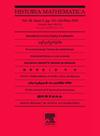Fabricius's theory for Mars: The model that shocked Kepler
IF 0.4
3区 哲学
Q3 HISTORY & PHILOSOPHY OF SCIENCE
引用次数: 0
Abstract
David Fabricius is recognized in the history of astronomy for his role in the discoveries of sunspots and the first variable star. As the around 50 letters between them show, he also played a significant role as Kepler's interlocutor when the latter was writing Astronomia Nova. One year before the publication of Astronomia Nova, Fabricius shared with Kepler a new model for Mars that he had developed. The model shocked Kepler because, using the traditional tools of circles and uniform motion, Fabricius had been able to find a model as accurate as Kepler's model involving his first two laws. The official story, based on the reconstruction of Fabricius's model that Apelt made in 1852, asserts that Kepler need not worry because, in fact, he misinterpreted the model. The true model that Fabricius proposed was not predictively accurate. In this paper I offer a new interpretation of Fabricius's model that shows that Kepler did indeed have reason to worry since Fabricius's model was extraordinarily accurate.
法布里修斯的火星理论:震惊开普勒的模型
大卫·法布里修斯因发现太阳黑子和第一颗变星而在天文学史上享有盛名。从他们之间的约50封信件中可以看出,在开普勒撰写《新天文学》时,他作为开普勒的对话者也发挥了重要作用。在《新天文学》出版前一年,法布里修斯与开普勒分享了他开发的火星新模型。这个模型震惊了开普勒,因为利用传统的圆和匀速运动的工具,法布里修斯已经能够找到一个和开普勒的模型一样精确的模型,包括他的前两个定律。官方的说法是基于1852年阿佩尔特对法布里修斯模型的重建,声称开普勒不必担心,因为事实上,他误解了这个模型。法布里修斯提出的真实模型在预测上并不准确。在本文中,我对法布里修斯的模型提供了一个新的解释,表明开普勒确实有理由担心,因为法布里修斯的模型非常准确。
本文章由计算机程序翻译,如有差异,请以英文原文为准。
求助全文
约1分钟内获得全文
求助全文
来源期刊

Historia Mathematica
数学-科学史与科学哲学
CiteScore
1.10
自引率
0.00%
发文量
29
审稿时长
72 days
期刊介绍:
Historia Mathematica publishes historical scholarship on mathematics and its development in all cultures and time periods. In particular, the journal encourages informed studies on mathematicians and their work in historical context, on the histories of institutions and organizations supportive of the mathematical endeavor, on historiographical topics in the history of mathematics, and on the interrelations between mathematical ideas, science, and the broader culture.
 求助内容:
求助内容: 应助结果提醒方式:
应助结果提醒方式:


